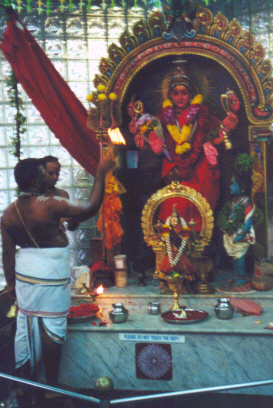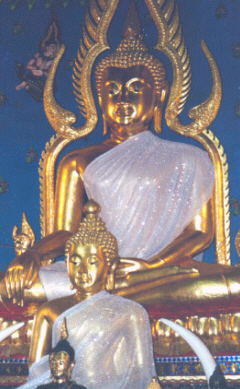|
Q: What is the Difference between Hinduism and Buddhism?
A: To the outsider, it may often appear that there is no real difference between Hinduism and Buddhism, particularly if one takes into account only the more philosophical, monistic form of Hinduism. Both seem to advocate the dissolving of oneself into a larger universal whole, and both seem to resort to the same ideas of karma and reincarnation as the fate of anyone who has not yet attained the final goal. In fact, if one looks at both religions through squinted eyelids so that all the finer distinctions are blurred, that observation is not far from the truth at all.
 Let me develop the similarities a little bit more. In the process some of the differences will already begin to emerge, and then I will close by highlighting the distinctions. First off, one needs to understand that Buddhism originally emerged within the context of Hinduism as a school of Hinduism, albeit a heretical one right from the start. Hinduism had been brought into India around 1500 B.C. through the migration of the Aryans, a group of people who carried with them a religion of many gods, many rules, and many rituals. (There is good reason to believe that the Aryans at one time in the remote past were monotheists, but that would have been much further back.) As the Aryans continued to settle into India, the religion became more complicated with even more gods, even more rules, and even more rituals. An exclusive alliance of priests established their privilege as the only legitimate custodians of the religions; they became the Brahmins, and all religious practice had to be performed by them alone. For all other people, it did not matter so much whether they understood their religion or not, just so long as it was carried out on their behalf correctly by the priesthood. Thus, in the eyes of many Indians, their religion had become a burden of duties and frequently meaningless ritual for the common people. Let me develop the similarities a little bit more. In the process some of the differences will already begin to emerge, and then I will close by highlighting the distinctions. First off, one needs to understand that Buddhism originally emerged within the context of Hinduism as a school of Hinduism, albeit a heretical one right from the start. Hinduism had been brought into India around 1500 B.C. through the migration of the Aryans, a group of people who carried with them a religion of many gods, many rules, and many rituals. (There is good reason to believe that the Aryans at one time in the remote past were monotheists, but that would have been much further back.) As the Aryans continued to settle into India, the religion became more complicated with even more gods, even more rules, and even more rituals. An exclusive alliance of priests established their privilege as the only legitimate custodians of the religions; they became the Brahmins, and all religious practice had to be performed by them alone. For all other people, it did not matter so much whether they understood their religion or not, just so long as it was carried out on their behalf correctly by the priesthood. Thus, in the eyes of many Indians, their religion had become a burden of duties and frequently meaningless ritual for the common people.
So, it is no surprise that eventually there would be wide-spread attempts to reform the religion in a way that would find greater significance behind the priest-administered ceremonies. In the sixth century B.C. there were a number of movements away from the priestly religion and into a direct mystical awareness that did not need to, in fact could not, be mediated by a priesthood.
 One such movement was the monistic form of Hinduism that emerged in the writings called the Upanishads and is frequently referred to as Vedanta. Vedantic Hinduism claimed that the entire universe, including the world of gods, religion, and ritual is illusionary. None of these things are truly real, and as long as one treats them as real, one misses the point of what is “really real.” The only genuine reality is the cosmic world soul, Brahman, which is beyond all categories of human thought and reason. But Brahman, infinite as it is, is also identical with the deepest layer of the human soul (atman), and so it becomes incumbent upon us to recognize the identity of our atman with Brahman, and then we can shift to a state of universal bliss (nirvana) after death. Until we reach that point, we are condemned to move from life to life on the virtually never-ending cycle of reincarnations, with the consequences of our actions (karma) determining what our next life will be. One such movement was the monistic form of Hinduism that emerged in the writings called the Upanishads and is frequently referred to as Vedanta. Vedantic Hinduism claimed that the entire universe, including the world of gods, religion, and ritual is illusionary. None of these things are truly real, and as long as one treats them as real, one misses the point of what is “really real.” The only genuine reality is the cosmic world soul, Brahman, which is beyond all categories of human thought and reason. But Brahman, infinite as it is, is also identical with the deepest layer of the human soul (atman), and so it becomes incumbent upon us to recognize the identity of our atman with Brahman, and then we can shift to a state of universal bliss (nirvana) after death. Until we reach that point, we are condemned to move from life to life on the virtually never-ending cycle of reincarnations, with the consequences of our actions (karma) determining what our next life will be.
Around the same time, the Buddha (Siddhartha Gautama) gained fame by preaching an even more radical message. He taught that truly nothing exists, not even the Brahman-atman identity of Vedantic Hinduism. Rather than one merging one’s atman into the one true reality of Brahman, one needs to realize that one’s non-self (anatman) is actually a part of the greater all-encompassing nothingness (sunyata). And even though there is no true self to be reincarnated from lifetime to lifetime, nonetheless, one’s identity is stamped on each link of a never-ending chain of existences, imprinted with the results of one’s karma. It is only by allowing oneself to become totally detached from all apparent reality that one can qualify for the ultimate state of nirvana, which is the Buddha characterized not as a state of bliss, but as a “blowing out,” an extinguishing of all identities and personal individuations.
 So we see that Vedantic Hindu and Buddhist philosophy move into opposite directions. For Hinduism, it becomes the final fulfillment of absolute being; by merging with Brahman one becomes, as it were, everything. Conversely, in Buddhism, one seeks for one’s final annihilation and to become, in the final analysis, nothing. Now, as we have emphasized on this web page many times, there is a great amount of variety within Hinduism, and the same diversity is true for Buddhism. Please take cognizance that I am writing in large generalities, even while I am specifically referring to one school of Hinduism only and a somewhat heavy-handed description of early Buddhist philosophy. However, these are the two points at which the two religions may appear to be the closest. So we see that Vedantic Hindu and Buddhist philosophy move into opposite directions. For Hinduism, it becomes the final fulfillment of absolute being; by merging with Brahman one becomes, as it were, everything. Conversely, in Buddhism, one seeks for one’s final annihilation and to become, in the final analysis, nothing. Now, as we have emphasized on this web page many times, there is a great amount of variety within Hinduism, and the same diversity is true for Buddhism. Please take cognizance that I am writing in large generalities, even while I am specifically referring to one school of Hinduism only and a somewhat heavy-handed description of early Buddhist philosophy. However, these are the two points at which the two religions may appear to be the closest.
On the level at which people actually live according to these religions, the difference is much greater. Neither Hindus nor Buddhists usually live according to esoteric philosophical concepts. Unless you find yourself in an intentionally syncretistic situation (which could be possible in, say, Southeast Asia or Indonesia), there is no way you could mistake a Hindu temple for a Buddhist one. Aside from simple matters of style—Hindu temples tend to abound in a plethora of colors, whereas Buddhist temples are usually more unified in style—the furnishings would be quite different. A Hindu temple has one of many deities in its main sanctuary and frequently also displays other gods in their own sanctuaries, while in Buddhist temples the central statue is always a Buddha, and far more rarely do we see further statues of a Buddha of another ages or of the same Buddha, and then clearly in a subordinated position. For Hinduism, the central act of worship is the puja, an offering of lights and fruits, with chanting and meditation normally taking a second place, while in Buddhism those priorities are reversed. The Hindu in his day-to-day existence first of all focuses on his or her obligations to the gods and spirits, an obligation that encompasses one’s moral actions and attitudes; for the Buddhist the focus is first of all on his or her actions and attitudes with ritual obligations being included in those mandates.
In the Western world, there is a good chance these days that, when we learn about Hinduism and Buddhism, we do so from someone who is already committed to the idea that all religions have a common core and so wind up glossing over fundamental differences. I have tried to show that, on a more theoretical level, there is a certain similarity in the abstract philosophies of the two religions, but even there they point into opposite directions. And when it comes to the actual practice of the religions, apart from the popular Western ideologies that try to cram all religions into the same mold, the differences become unmistakable. I have added some pictures to this little essay. One is of Hindu priests performing a puja to a Hindu deity, the other two are of a Buddha statue and of Buddhist monks chanting at a Buddhist funeral. I think you will recognize the difference pretty easily.
Finally, let me leave you with one observation. Understanding that there are differences between religions and what those differences are is one step in the right direction. But you cannot stop there. Since the religions make mutually exclusive truth claims, sooner or later you will have to face the question of which of them is true. I pray that you will see that the unique claims that Christianity makes on its behalf are also ones that can be substantiated.
|
